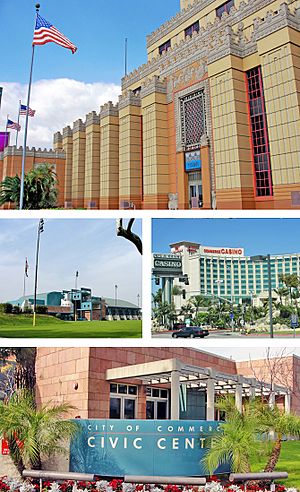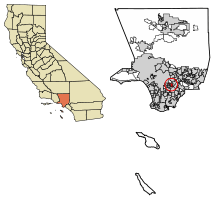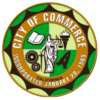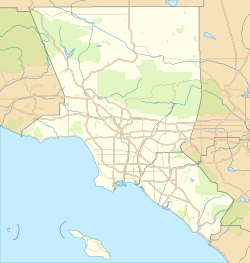Commerce, California facts for kids
Quick facts for kids
Commerce, California
|
|||
|---|---|---|---|

Images, from top, left to right: Citadel Outlets, Rosewood Park and Aquatorium, Commerce Casino, Civic Center
|
|||
|
|||
| Motto(s):
"The Model City"
|
|||

Location of Commerce in Los Angeles County, California.
|
|||
| Country | |||
| State | |||
| County | Los Angeles | ||
| Incorporated | January 28, 1960 | ||
| Area | |||
| • Total | 6.53 sq mi (16.92 km2) | ||
| • Land | 6.53 sq mi (16.92 km2) | ||
| • Water | 0.00 sq mi (0.00 km2) 0.02% | ||
| Elevation | 141 ft (43 m) | ||
| Population
(2020)
|
|||
| • Total | 12,378 | ||
| • Density | 1,894.69/sq mi (731.49/km2) | ||
| Time zone | UTC−8 (PST) | ||
| • Summer (DST) | UTC−7 (PDT) | ||
| ZIP Codes |
90022–90023, 90040, 90091
|
||
| Area code(s) | 213/323/562 | ||
| FIPS code | 06-14974 | ||
| GNIS feature IDs | 1660503, 2410209 | ||
Commerce is a city in southeast Los Angeles County, California, United States. It is often called the City of Commerce to avoid confusion with the general word "commerce." In 2020, about 12,378 people lived there. The city's motto is "The Model City."
Commerce shares borders with several other cities. These include Vernon to the west and Los Angeles to the northwest. To the east is Montebello, and to the south are Downey and Bell Gardens. The Los Angeles River and Rio Hondo are natural boundaries. Major roads like the Long Beach Freeway and Santa Ana Freeway run through it. You can also get there by Metrolink train at the Commerce station.
Contents
History of Commerce
How Commerce Grew
In the 1800s, the land where Commerce now stands was part of a large ranch. Things started to change in 1887 when the Atchison, Topeka and Santa Fe Railway built a main train line here. Later, other railroads like the Union Pacific and Pacific Electric Railway also came through.
By the 1920s, factories began to appear in the area. In the late 1940s, business leaders and local residents worked together. They wanted to encourage more businesses, so they changed the name of their communities to "Commerce."
Becoming an Official City
Commerce officially became a city in 1960. This was done to stop nearby cities from taking over its industrial land. Keeping this land meant Commerce could collect taxes from businesses. This helped the city grow and provide services for its residents. Maurice Quigley was elected as the first mayor.
In the 1970s and 1980s, many factories in other cities closed down. But Commerce managed to keep many of its manufacturing and goods-distribution businesses. It also turned old factory sites into new shopping areas. A great example is the Citadel Outlets mall. This popular shopping center is built on the site of an old tire factory. The owner of the Citadel, Steve Craig, helps organize a "Clean Up Commerce Day" each year. Businesses and volunteers work together to make parts of the city look better.
Commerce also has a large rail yard. This has helped the city benefit from international trade. Goods coming through the ports of Los Angeles and Long Beach often pass through Commerce.
Geography of Commerce
Commerce covers an area of about 6.5 square miles (16.9 square kilometers). Almost all of this area is land.
People of Commerce
Population Changes Over Time
The number of people living in Commerce has changed over the years:
- 1960: 9,555 people
- 1970: 10,635 people
- 1980: 10,509 people
- 1990: 12,135 people
- 2000: 12,568 people
- 2010: 12,823 people
- 2020: 12,378 people
Who Lives in Commerce (2010 Census)
In 2010, Commerce had 12,823 residents. Most people lived in homes, with very few in group living situations. About 94.5% of the people identified as Hispanic or Latino.
The city has a mix of ages. About 29.8% of residents were under 18 years old. The average age was around 31.2 years. Many households had children living in them.
Economy in Commerce
Commerce is known for its many businesses and industries. This is why it's called "The Model City."
Top Employers in Commerce
Many companies provide jobs in Commerce. Here are some of the biggest employers:
| # | Employer | # of Employees |
|---|---|---|
| 1 | Commerce Casino | 2,191 |
| 2 | County of Los Angeles | 910 |
| 3 | Parsec | 890 |
| 4 | Smart & Final | 769 |
| 5 | Unified Grocers | 748 |
| 6 | American International Industries | 592 |
| 7 | Mission Foods | 590 |
| 7 | 99 Cents Only Stores | 549 |
| 9 | Megatoys | 480 |
| 10 | Wine Warehouse | 376 |
| 11 | Valassis Direct Mail | 350 |
| 12 | Gibson Overseas | 346 |
| 13 | City of Commerce | 315 |
| 14 | AT&T California | 302 |
Kimlan Foods USA also has its main office in Commerce.
Education in Commerce
Most students in Commerce attend schools in the Montebello Unified School District. A smaller part of the city is served by the Los Angeles Unified School District.
Montebello Unified School District Schools
- Elementary Schools:
* Bandini Elementary School (in Commerce) * Suva Elementary School (in Bell Gardens)
- Intermediate Schools:
* Bell Gardens Intermediate School (in Bell Gardens) * Suva Intermediate School (in Bell Gardens) * La Merced Intermediate School (in Montebello)
- K–8 Schools (Kindergarten through 8th grade):
* Rosewood Park School (in Commerce)
- High Schools:
* Bell Gardens High School (in Bell Gardens) * Montebello High School (in Montebello) * Schurr High School (in Montebello)
Los Angeles Unified School District Schools
- Ford Boulevard Elementary School (in Unincorporated Los Angeles County)
- Griffith Middle School (in Unincorporated Los Angeles County)
- Garfield High School (in Unincorporated Los Angeles County)
City Services
Emergency Services
Commerce has important services to keep its residents safe.
Fire Services
The Los Angeles County Fire Department (LACFD) provides fire protection for Commerce. Their main office is actually in Commerce. They have three fire stations located within the city. Care Ambulance Service provides ambulance transport.
Police Services
The Los Angeles County Sheriff's Department (LASD) handles police services for Commerce. Their East Los Angeles Station serves the city.
Friendship City
Commerce has a special connection with Nanning, a city in Guangxi, China. They are considered "friendship cities."
Images for kids
See also
 In Spanish: Commerce para niños
In Spanish: Commerce para niños







